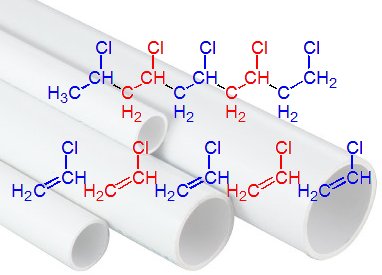
In a polymer, the individual links are small molecules that get connected together to make one big long molecule. For instance, PVC, or polyvinylchloride, starts out with separate molecules of chloroethane made up of two carbon atoms, three hydrogen atoms, and one chlorine atom. In the image below I show just five molecules coming together to make a short chain (color coded to make them easier to see), but in a polymer you will have hundreds or thousands of links connected to each other.

ABS is a more complex polymer made of three pieces. The A is acrylonitrile (blue in the picture below), B is butadiene (magenta) and S is styrene (red). This is called a copolymer. You could put these together in any number of different ways. For instance, the chain could be ABSABSABSABSABSABS, or AAABBBSSSAAABBBSSS, or AAAAABSAAAAABSAAAAABS. The different patterns, and relative amounts of the three pieces, will lead to polymers with different properties. I wasn't able in a quick search to find the exact mix in the plastic that LEGO uses, so I showed one industrial instance that divides the chains up into two blocks - sections of repeating ASASAS and other sections of repeating BBBBB. This plastic is produced in small pellets (often with color agents and other inclusions, though my photo just shows some raw uncolored pellets) which are then used for the injection molding process.

No comments:
Post a Comment